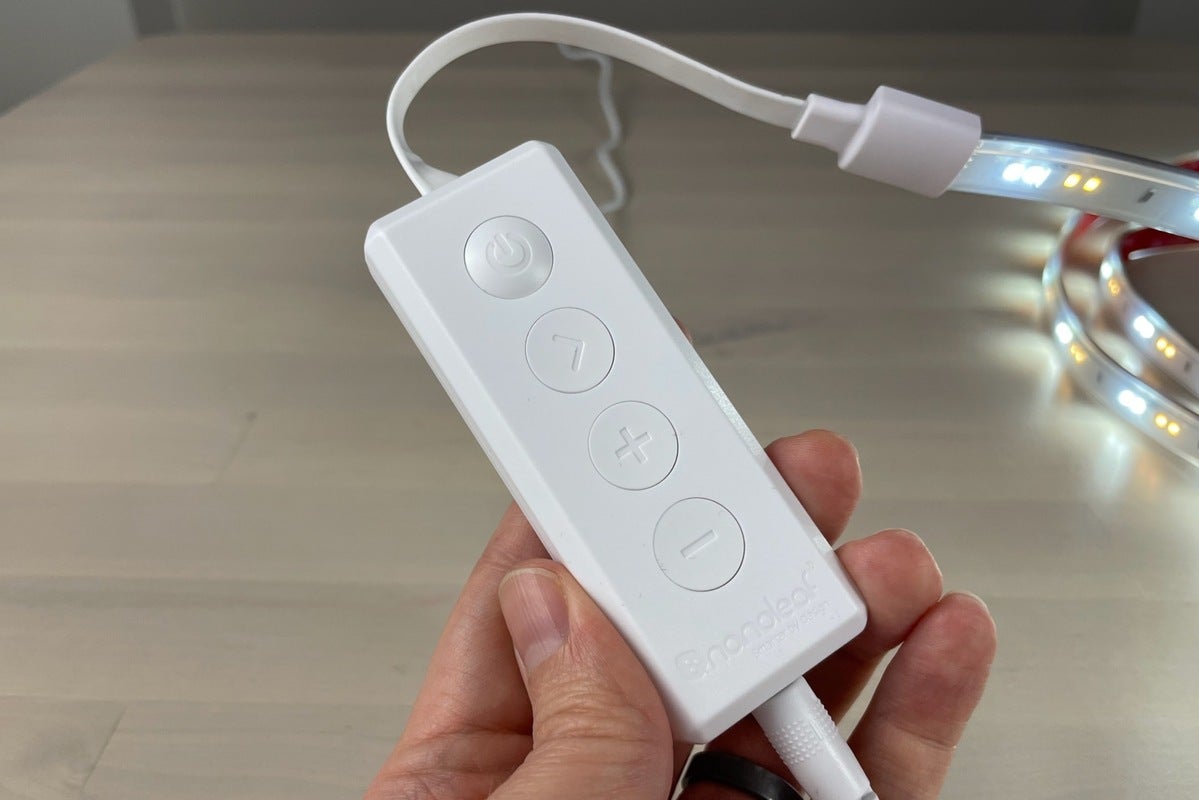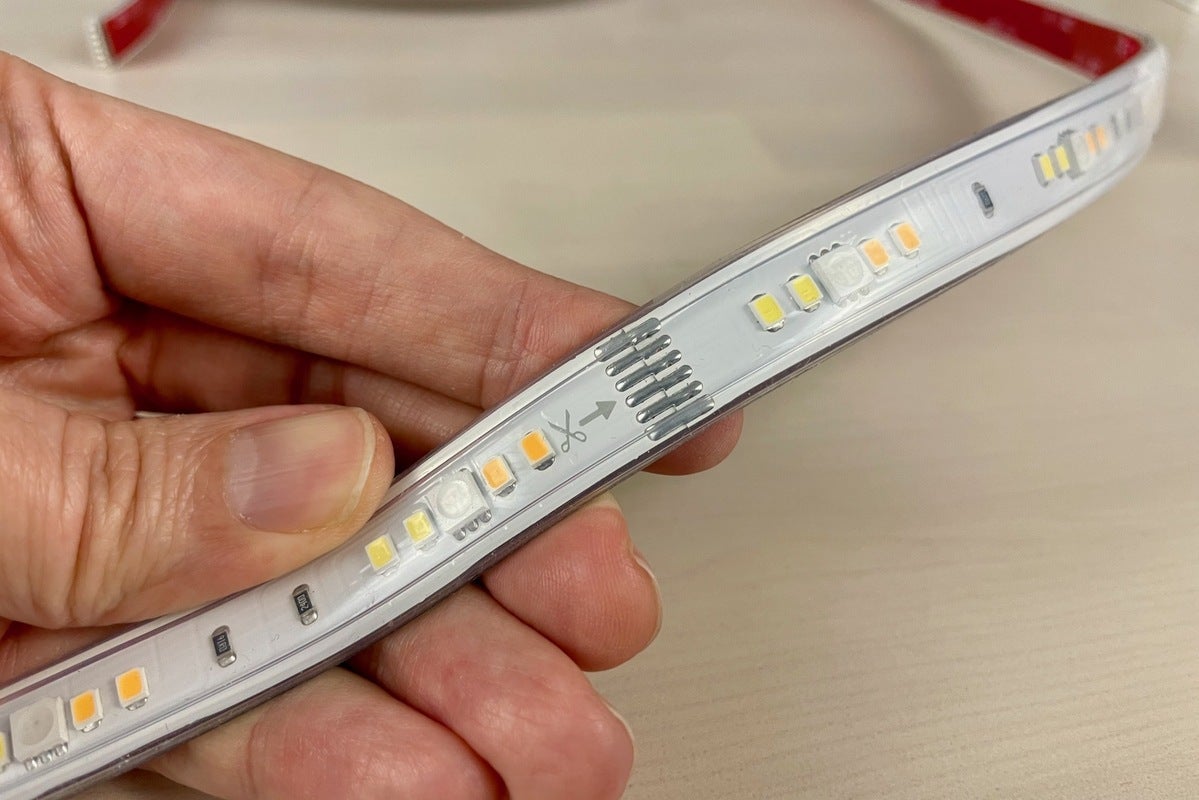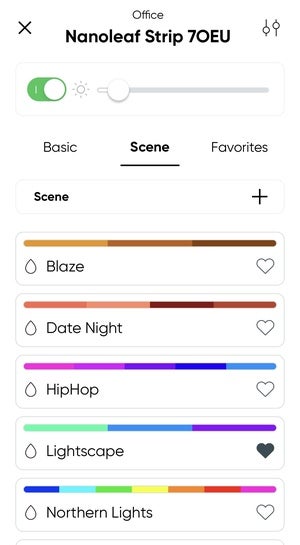Smart LED light strips that are well designed yet reasonably priced are hard to come by, which is why we’re enthusiastic—to a degree, anyway—about the Nanoleaf Essentials Lightstrip. Compatible with Apple HomeKit and Google Assistant, this bright, 80-inch light strip benefits from easy setup and Nanoleaf’s sleek mobile app. And at just $50, it’s considerably less expensive than the competing Philips Hue Lightstrip Plus. But like Nanoleaf’s other Essential’s product, a 120-sided A19 smart bulb, the Essentials Lightstrip comes with some important and potentially deal-breaking caveats.
For starters, the Lightstrip’s most advanced features depend on Thread, the IP-based wireless protocol backed by such tech stalwarts as Apple, Google, and Samsung. Thread is attractive for a number reasons, including low latency, low power consumption, and—best of all—beefed-up security. Thread requires a “border” router, and the only consumer model on the market right now is Apple’s $99 HomePod Mini. If you don’t already have one, that adds a hefty premium to the Lightstrip’s cost of entry.
This review is part of TechHive’s coverage of the best smart LED bulbs, where you’ll find reviews of the competition’s offerings, plus a buyer’s guide to the features you should consider when shopping this category.
A cheaper alternative would be to skip the HomePod Mini and control the Lightstrip via Bluetooth; doing so, however, means you’ll miss out on some of the Lightstrip’s best features, including the ability to control it outside your home. And speaking of key features, many of them—namely the ability to sync with computer monitors, music, and Nanoleaf’s Shapes light panels—aren’t ready for prime time yet.
Finally, you might have noticed an important smart home integration that the Essentials Lightstrip decidedly doesn not support: Alexa. That alone could be a deal-breaker for smart home users who are deeply invested in Amazon’s smart home ecosystem.
Configuration
There are currently just two products in Nanoleaf’s Essentials line: the Lightstrip reviewed here, and the A19 Essentials color bulb. Nanoleaf says that more Essentials products are on the way, and we’ve seen promotional materials that picture BR30 floodlights, decorative candle bulbs, and GU10 and GU24 downlights, but Nanoleaf hasn’t made any of those lights official yet.
The Lightstrip itself is about two meters (80 inches) long and a little over a half-inch wide, with about 21 LEDs per meter in groups of five. You can also add up to eight 1-meter extensionsRemove non-product link ($25 each) to the Lightstrip, for a total length of 10 meters; if you add more extensions beyond 10 meters, the brightness of the LEDs will start to dim.
There’s a peel-and-stick adhesive backing on the opposite side of the strip, while a 5.7-inch cable connects a palm-sized controller to one end. That controller, in turn, connects to a nearly two-meter power cord, which terminates in a chunky AC adapter that’s large enough to block nearby outlets. It’s worth noting that only the Lightstrip “Starter Kit” includes the controller and the AC adapter, while the 1-meter extension comes only with the light strip itself.
 Ben Patterson/IDG
Ben Patterson/IDG
The in-line controller for the Nanoleaf Essentials Lightstrip includes buttons for power, brightness, and for cycling through color scenes.
Rated to last up to 25,000 hours, the Essentials Lightstrip’s white light can be tuned from a warm 2,700 Kelvin (about the same color temperature as a warm-white bulb for a bedroom) to a cool 6,500K (which is equivalent to daylight on a hazy day). The Lightstrip can also glow in up to 16 million colors, but only in a single color at a time; in other words, don’t expect to see any rainbow patterns.
Nanoleaf says the Lightstrip has an average brightness of 2,000 lumens and a maximum brightness of up to 2,200 lumens, which makes it one of the brighter light strips we’ve tested. Cranking the brightness all the way up on my review unit, the Lightstrip easily lit up my office.
Setup
If you’ve ever installed a peel-and-stick light strip on a wall, under a cabinet, or elsewhere in your home, you’ll know what to expect when setting up the Nanoleaf Essentials Lightstrip.
The first step is to measure and, if necessary, cut for length. Of course, you can’t just cut anywhere on the light strip; instead, you can only cut along designated markings that are about 13 inches apart, which means the final length of the strip may be longer or shorter than you’d like. That’s a limitation that’s common to all the LED light strips we’ve tested.
 Ben Patterson/IDG
Ben Patterson/IDG
You can cut the Nanoleaf Essentials Lightstrip to fit, but you can only snip along designated areas that are spaced about 13 inches apart.
Once you’ve cut the Lightstrip to the ideal length, you peel off the plastic covering that protects the adhesive backing and then stick the strip to the surface you’ve chosen (ideally one that’s clean and perfectly flat). Then you’ll need to remove the plastic covering on the controller’s rear adhesive pads and stick that to the same (or a nearby) surface, and finally you plug the AC adapter into a wall outlet.
With the physical setup out of the way, it’s time to connect the Lightstrip to HomeKit. Whether you have a Thread-enabled HomePod Mini or you’re planning on controlling the Lightstrip via Bluetooth, the process is the same: simply fire up the Apple Home app and scan the QR code on the Lightstrip’s AC adapter. When you do, the app will automatically add the Lightstrip to your collection of other HomeKit devices. Not an iOS user? You can connect to the Lightstrip and control it using the Google Home app.
As with Nanoleaf’s Essentials A19 bulb, you don’t need a HomePod Mini to control the Essentials Lightstrip; your phone’s Bluetooth connection will let you turn the light strip on and off, change its color temperatures, cycle between lighting scenes, and set schedules. Without a Thread border router, however, you’ll miss out on the advanced functionality that’s coming soon to Nanoleaf’s Essentials lights (more on those in a bit), and you’ll also need to be in Bluetooth range (as in 33 feet or so) to control the strip.
If you do choose to add a Thread-enabled HomePod Mini to your setup, the upgrade process is seamless. As soon as you power up the HomePod Mini and connect it to your home network, it will silently connect to the light strip via Thread. When I made the switch, I noticed that the Essentials Lightstrip began responding to commands from my phone more quickly. And because the HomePod Mini also acts as a smart home hub, it allows you to control the Lightstrip even when you’re away from home.
Features and functionality
Unfortunately, some of the Nanoleaf Essentials Lightstrip’s most enticing features have yet to be rolled out. For example, Nanoleaf says the Lightstrip will—eventually—be able to mirror the colors on your Mac or Windows monitor, which could lead to some nifty effects if you install the Lightstrip on the back of your computer screen as a bias light. But while some of Nanoleaf’s other products, such as its Shapes light panels, already can sync with Mac and PC monitors (with help from a desktop application), the feature has yet to arrive for Nanoleaf’s Essentials line, including the Lightstrip.
A couple of other advanced features are also circling the airport: the ability to sync with the colors on Nanoleaf’s Shapes panels, as well as the ability to sync with music. As with the PC monitor syncing, music and Shapes syncing would be ideal features for the Essentials Lightstrip; indeed, I’d love to sync my Lightstrip sample unit with the Shapes panels I have installed on the wall directly above it. Alas, as of this writing, Nanoleaf will only say that they’re coming sometime in 2021. It’s also worth noting that all of these upcoming syncing features require a Thread connection.
 Ben Patterson/IDG
Ben Patterson/IDG
It would be cool to sync the Nanoleaf Essentials Lightstrip (it’s installed behind the rear rim of my testbench) with the Nanoleaf Shapes panels situated above; unfortunately, that feature is still in the works.
The good news is that a couple of promised features for the Essentials line have recently arrived. One of them is support for Apple’s Adaptive Lighting feature, which automatically tunes the color temperature of your lights according to the time of day in your region. The other is the ability to apply color scenes, including such animated scenes as “Date Night,” “HipHop,” “Lightscape,” “Northern Lights,” and “Starlight.” You can even create your own color scenes with help from a touch interface that lets you customize how long the various colors appear before cycling to the next.
 Ben Patterson/IDG
Ben Patterson/IDG
You can use the Nanoleaf app to choose various animated color scenes for the Essentials Lightstrip.
Besides its new Adaptive Lighting support and color scenes, the Essentials Lightstrip has a solid lineup of other features, which are more or less identical to those available for the Essentials A19 bulb. You can read the details here, but suffice to say that both lights offer a circadian lighting feature (Nanoleaf’s take on Apple’s Adaptive Lighting), while the Nanoleaf app boasts a redesigned color picker. The app also lets you group the light strip with other Essentials lights, Nanoleaf’s Shapes light panels, and other compatible smart lights (such as those from Philips Hue).
You can put the Essentials Lightstrip on a schedule with help from either the Apple Home or Google Home apps, which offer both daily and weekly schedules along with sunset/sunrise triggers. The Lightstrip also works with HomeKit and Google Assistant routines, including Google’s new Gentle Sleep and Wake feature (which slowly dims your lights at bedtime and gradually ups the brightness in the morning).
As with the Essentials A19 bulb, the Essentials Lightstrip’s smart home integrations are limited to HomeKit and Google Assistant, which means it’s not compatible with Alexa. A Nanoleaf rep had no information when—or if—Alexa support might arrive for the Essentials line.
Bottom line
As with the Essentials A19 bulb, Nanoleaf’s promising Essentials Lightstrip is a work in progress. On the one hand, you’ll be hard-pressed to find a smart LED light strip that’s this bright and boasts such easy setup and extensive features, not to mention Bluetooth, Google Assistant, and HomeKit support. On the other hand, the light strip’s Thread connectivity means you’ll need a $99 HomePod Mini to unlock its full potential—at least until more Thread border routers are available. And for now, the Lightstrip’s enticing light-syncing abilities are unfinished. The Essentials Lightstrip could be a good choice for smart home shoppers who have both a HomePod Mini and a dash of patience, but others might be better off adopting a wait-and-see approach.
"light" - Google News
February 19, 2021 at 06:00PM
https://ift.tt/3ufQLzd
Nanoleaf Essentials Lightstrip review: A bright, affordable and Thread-enabled LED light strip - TechHive
"light" - Google News
https://ift.tt/2Wm8QLw
https://ift.tt/2Stbv5k
Bagikan Berita Ini














0 Response to "Nanoleaf Essentials Lightstrip review: A bright, affordable and Thread-enabled LED light strip - TechHive"
Post a Comment